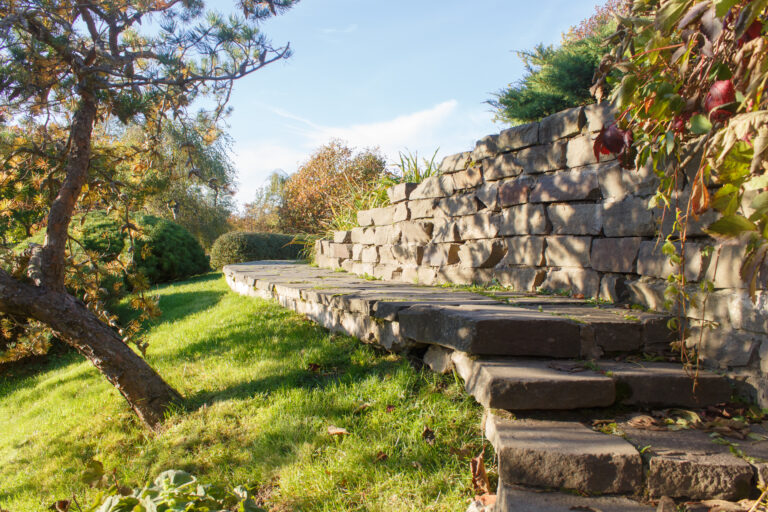Table of Contents

DIY Retaining Wall Installation
Advantages
Budget-Friendly Flexibility – Going the DIY route eliminates labor costs, letting you allocate more budget to high-quality materials, custom aesthetics, or supplementary design features like integrated planters or lighting.
Creative Freedom Every Step of the Way – You control the wall’s style, layout, and finishing touches. Whether it’s experimenting with textures, color tones, or patterning, your creative choices drive the outcome.
Skill Development & Pride of Ownership – Building the wall yourself is a useful learning experience—from leveling, drainage, to soil mechanics—you pick up hands-on knowledge. Plus, the pride in your workmanship is impactful.
Disadvantages
Intensive Preparation vs. Visible Work – A far greater part of building a durable wall lies below the surface—leveling the base, ensuring solid compaction, and managing backfill—none of which is flashy, but all vital for longevity.
Substantial Physical & Technical Demands – The real work isn’t stacking blocks—it’s moving earth, leveling precisely, and managing heavy materials. Without the right tools and stamina, time easily doubles or triples.
Potential for Oversights & Code Violations – Missing a permit, ignoring drainage, or misreading slope dynamics can lead to structural failure or fines. Even small errors in planning can cascade into major problems.
Limited Material Access – Most DIYers select from what’s available at retail stores, but they may miss out on advanced materials or installation systems that pros access, diminishing both performance and aesthetics.
Professional Retaining Wall Installation
Advantages
Precision Engineering & Long-Term Durability – Pros design walls with the right footing depth, load-bearing calculations, and drainage strategies to suit local soil and climate conditions, ensuring the structure withstands time and weather.
Seamless Project Management – From securing permits to sourcing materials and scheduling inspections, professionals manage the entire process—delivering efficiency and accountability every step of the way.
Strength Through Warranty & Liability Protection – Professional work often comes with guarantees, insurance coverage during construction, and the reassurance that mistakes won’t cost you out of pocket.
Access to High-Quality Materials & Specialized Tools – Contractors can tap into supply networks for commercial-grade blocks, drainage systems, and engineering-grade reinforcement that aren’t typically available to retail buyers.
Disadvantages
Higher Upfront Investment – Your initial outlay will be higher. Labor, design, permitting, and insurance add to costs—even if this often means avoiding the future cost of failure.
Less Personal Engagement in the Process – If you enjoy rolling up your sleeves and shaping the project yourself, a hands-off experience may feel less fulfilling. The wall becomes someone else’s vision, even if built to your specs.
Fresh Insights from “DIY vs. Professional” Thinking
DIY Success Relies on Project Simplicity – Projects with straightforward design—low walls, simple lines, and favorable soil—are far more manageable. The more complex your vision, the higher the likelihood that professionals will deliver better results.
Effort Distribution is Skewed toward Subsurface Work – A surprising reality for DIYers: roughly 80% of the effort involves preparing the foundation and managing drainage; the visible stacking is just a small fraction. One major benefit of hiring a pro is their expertise in water management. Drainage isn’t just about keeping your yard dry—it protects your home’s foundation too. For more tips, see our guide on 8 Ways to Improve Drainage Around Your House.
Material Knowledge Matters – Experts bring a depth of knowledge about block types, their drainage properties, and positioning. Choosing the right material goes beyond looks—it influences longevity and structural performance. Professionals can also combine retaining walls with landscape rock for a low-maintenance, polished look. Learn more in our guide on 7 Reasons Why Homeowners Should Install Landscape Rock.
Local Conditions Define Requirements – Whether it’s freeze–thaw cycles, clay-rich soil, or specific code thresholds, professionals understand what adaptations are needed per region—something often overlooked in DIY planning.

How to Decide: Key Considerations
| Factor | DIY Approach | Hiring a Professional |
|---|---|---|
| Budget | Lower initial cost, though the risk of costly future failure exists. | Higher upfront, but avoids mistakes—and often includes warranty protection. |
| Time & Labor | Demanding and prolonged; back-end-heavy with grading and prep work. | Fast and streamlined, with teams and tools that speed up complex tasks. |
| Complexity & Design | Best for low, simple walls with straightforward layouts. | Ideal for tall, curved, or integrated designs that require engineering. |
| Durability | Dependent on your execution; mistakes may shorten lifespan significantly. | Built to last decades with proper drainage, compaction, and materials. |
| Permits & Regulation | Easy to miss critical requirements—risking fines or forced rebuilding. | Professionals handle approvals, codes, and inspections seamlessly. |



